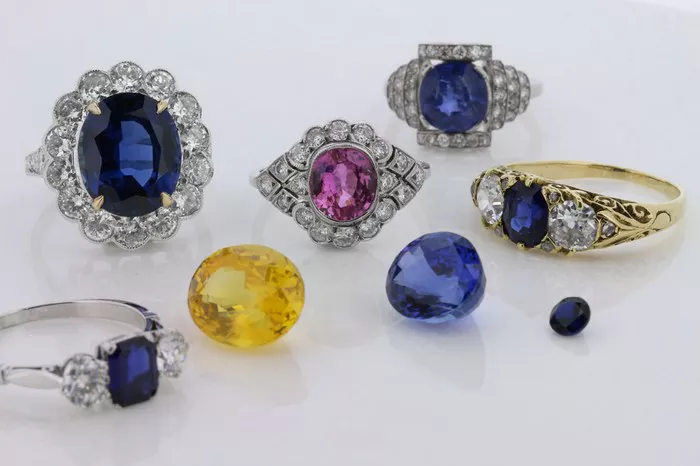Jewelry appraisal involves a comprehensive understanding of gemstone characteristics, origins, market trends, and consumer preferences. When comparing the prices of sapphires and diamonds, several factors must be considered to provide a nuanced answer. This article aims to explore this question in detail, providing a thorough introduction to the topic.
Introduction to Sapphires and Diamonds
Sapphire
Sapphire, a member of the corundum family, is renowned for its hardness, which ranks second only to diamond on the Mohs scale. Its hardness ensures durability, making it an ideal choice for jewelry. Sapphire’s color range is vast, with blue being the most popular and valuable. The finest blue sapphires are described as “Royal Blue,” exhibiting a deep, vivid hue. Other colors such as pink, yellow, green, and white (known as white sapphire or colorless sapphire) are also available, each with its own unique charm and market value.
Sapphire’s origin plays a crucial role in determining its price. Sapphires from certain locations, such as Kashmir, Myanmar (Burma), and Sri Lanka, are highly valued due to their exceptional quality and rarity. These gems often fetch higher prices at auctions and in the market.
Diamond
Diamond, the hardest natural substance known, has been a symbol of luxury and romance for centuries. Its brilliance, fire, and scarcity contribute to its high value. Diamonds are graded based on the 4Cs: Cut, Clarity, Color, and Carat. A well-cut diamond with high clarity, minimal color (typically referring to a colorless or near-colorless diamond), and a larger carat weight will command a higher price.
Diamond prices can vary widely, influenced by market demand, mining production, and geopolitical factors. For instance, a one-carat diamond can range in price from 80,000, depending on its quality characteristics.
Factors Influencing Sapphire and Diamond Prices
Quality
Quality is the cornerstone of gemstone pricing. For sapphires, factors such as color saturation, tone, and purity, as well as clarity (the presence of inclusions or flaws), cut (shape and proportioning), and carat weight, influence value. Blue sapphires, particularly those with a strong, vivid blue hue, are the most sought-after and expensive.
Diamonds are evaluated using the 4Cs mentioned earlier. A diamond with exceptional clarity, an ideal cut that maximizes brilliance and fire, and a desirable color grade (typically D-Z on the GIA color scale, with D being completely colorless) will fetch a premium price.
Origin
The origin of a gemstone can significantly impact its price. Sapphires from Kashmir, Myanmar, and Sri Lanka are highly esteemed due to their historical significance, rare occurrence, and exceptional quality. These origins often fetch higher prices compared to sapphires from other regions.
Diamonds are sourced from various mines worldwide, including those in Africa, Russia, Canada, and Australia. Certain mines are known for producing high-quality diamonds, which can influence pricing. For example, diamonds from the Cullinan mine in South Africa are highly valued due to their size and quality.
Market Demand
Market demand plays a significant role in gemstone pricing. Consumer preferences, economic conditions, and fashion trends all contribute to fluctuations in demand. During times of economic prosperity, demand for luxury items like sapphires and diamonds tends to increase, driving up prices. Conversely, during economic downturns, demand may decline, resulting in lower prices.
Supply
Supply is another critical factor influencing gemstone prices. Mining production, resource availability, and geopolitical stability can affect the supply of sapphires and diamonds. For example, a decrease in mining output due to resource depletion or political unrest can lead to increased prices, as supply becomes constrained relative to demand.
Comparing Sapphire and Diamond Prices
Determining whether sapphires are more expensive than diamonds involves examining specific quality and market conditions. Generally, high-quality sapphires and diamonds can fetch equally high prices, but the comparison often depends on individual characteristics.
High-Quality Sapphires
Exceptional sapphires, particularly those with a vivid “Royal Blue” hue, high clarity, and well-cut proportions, can command prices rivaling those of high-quality diamonds. For instance, at auctions, sapphires with carat weights exceeding 20 and exceptional quality have fetched prices exceeding $4 million. These gems are rare and highly valued by collectors and investors.
High-Quality Diamonds
Similarly, high-quality diamonds with exceptional clarity, color, cut, and carat weight can fetch very high prices. For example, a one-carat diamond with an ideal cut, D color grade, and flawless clarity can sell for upwards of $50,000 or more. These diamonds are sought after for their brilliance, fire, and scarcity.
Mid-Range and Lower-Quality Gemstones
In the mid-range and lower-quality categories, diamonds tend to be more affordable than sapphires of comparable quality. This is due to diamonds’ higher availability and broader consumer appeal. Mid-range diamonds, with good clarity, color, and cut, can be purchased at more accessible price points, making them more affordable for the average consumer.
Consumer Preferences
Consumer preferences also play a role in gemstone pricing. Some consumers prefer the timeless elegance of diamonds, while others appreciate the unique colors and histories of sapphires. This preference can influence market demand and pricing.
Conclusion
Determining whether sapphires are more expensive than diamonds is not a straightforward question. It depends on various factors, including quality, origin, market demand, supply, and consumer preferences. High-quality sapphires and diamonds can fetch equally high prices, reflecting their unique characteristics and desirability. In the mid-range and lower-quality categories, diamonds tend to be more affordable due to their higher availability and broader consumer appeal.Ultimately, the value of a gemstone is subjective and influenced by personal taste, cultural significance, and emotional attachment. Whether you prefer the timeless elegance of a diamond or the vibrant hues of a sapphire, understanding these factors can help you make informed decisions when purchasing or investing in gemstones.
Related topic:
- Can Yellow Sapphire and Cat’s Eye Be Worn Together?
- Can Yellow Sapphire and Blue Sapphire Be Worn Together?
- Can Ruby and Yellow Sapphire Be Worn Together?


